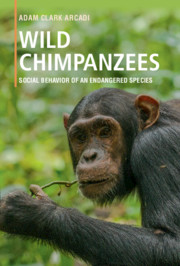Book contents
- Wild Chimpanzees
- Wild Chimpanzees
- Copyright page
- Dedication
- Contents
- Preface
- 1 Primates, Apes, and the Study of Chimpanzee Social Behavior
- 2 Seven Long-Term Field Studies
- 3 Chimpanzee Fission–Fusion Social Organization and Its Conservation Implications
- 4 Sex Differences in Ranging and Association Patterns
- 5 Female Social Relationships
- 6 Male Social Relationships
- 7 Sexual Behavior: Conflicting Strategies of Males and Females
- 8 Coalitionary Lethal Aggression between and within Communities
- 9 Hunting, Eating, and Sharing Meat
- 10 Communication: The Form and Content of Signals
- 11 Community Differences in Grooming Postures and Tool Use: Innovation, Social Learning, and the Question of “Culture”
- Epilogue
- Appendix: Field Methods for Studying Wild Chimpanzees
- End Notes
- References
- Index
- Plate Section (PDF Only)
3 - Chimpanzee Fission–Fusion Social Organization and Its Conservation Implications
Published online by Cambridge University Press: 01 June 2018
- Wild Chimpanzees
- Wild Chimpanzees
- Copyright page
- Dedication
- Contents
- Preface
- 1 Primates, Apes, and the Study of Chimpanzee Social Behavior
- 2 Seven Long-Term Field Studies
- 3 Chimpanzee Fission–Fusion Social Organization and Its Conservation Implications
- 4 Sex Differences in Ranging and Association Patterns
- 5 Female Social Relationships
- 6 Male Social Relationships
- 7 Sexual Behavior: Conflicting Strategies of Males and Females
- 8 Coalitionary Lethal Aggression between and within Communities
- 9 Hunting, Eating, and Sharing Meat
- 10 Communication: The Form and Content of Signals
- 11 Community Differences in Grooming Postures and Tool Use: Innovation, Social Learning, and the Question of “Culture”
- Epilogue
- Appendix: Field Methods for Studying Wild Chimpanzees
- End Notes
- References
- Index
- Plate Section (PDF Only)
Summary
OVERVIEW
Chimpanzees live in mixed-sex social groups, called “unit-groups” or “communities.” Communities range in size from 10 to more than 200 individuals, with adult sex ratios varying between 1:1.35 and 1:4 (males:females). Males live for their entire lives in the groups they are born into, whereas females generally emigrate to neighboring communities when they reach reproductive age and remain there permanently. Neighboring communities utilize discrete territories, and adult males regularly monitor the slightly overlapping boundary zones between them. Encounters between males in these areas are typically hostile. Groups of males, sometimes accompanied by females and younger individuals, occasionally make forays into neighboring territories where, if they enjoy numerical superiority, they will attack neighbors of either sex (Chapter 9). Territorial boundaries shift depending on the outcomes of these intercommunity conflicts.
In contrast to most other primates that live in stable social groups, chimpanzees do not stay in constant contact with all members of their community. Instead, individuals forage and socialize in smaller subgroups, or “parties,” that usually contain fewer than ten individuals of one or both sexes and are scattered throughout their home range (Plate 3). Membership in parties, or “party composition,” changes frequently, sometimes several times in the same day, and rarely remains the same for more than a few days. Most community members utilize the entirety of the community territory over the course of a year, although significant individual and sex differences exist in ranging behavior (Chapter 5). This regular reshuffling of subgroup membership and variation in ranging behavior produces a comparatively rare grouping pattern referred to as fission–fusion social organization, as mentioned in Chapter 1.
The rhythm of daily life for chimpanzees reflects a synergy between three factors in particular. First, ripe fruits, the primary food of chimpanzees, occur in comparatively small, widely dispersed patches most of the time. This means that individuals are frequently forced to forage alone or in small groups, searching widely for fruiting trees. At the same time, the need for cooperative defense of communal territory, which guarantees access to food resources, depends on the maintenance of strong social bonds among males. Males therefore spend considerable amounts of time associating and grooming together when ecological conditions permit.
- Type
- Chapter
- Information
- Wild ChimpanzeesSocial Behavior of an Endangered Species, pp. 27 - 32Publisher: Cambridge University PressPrint publication year: 2018



